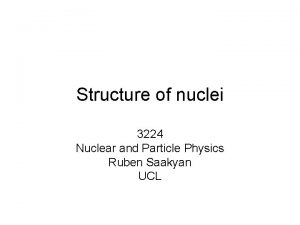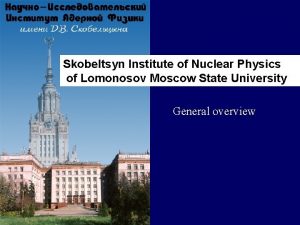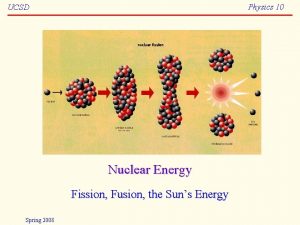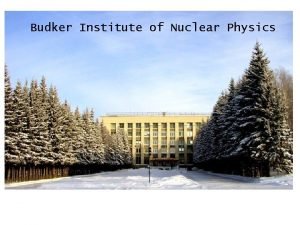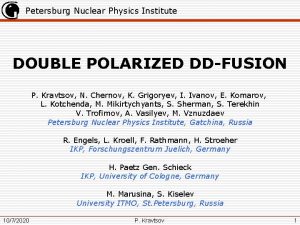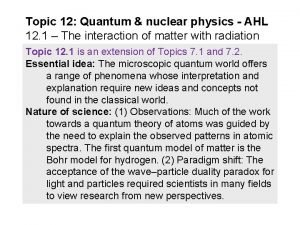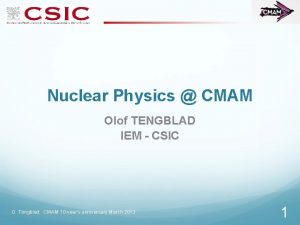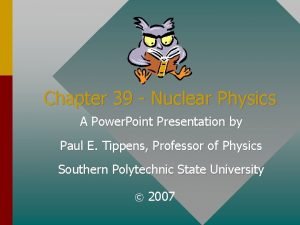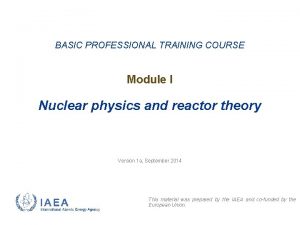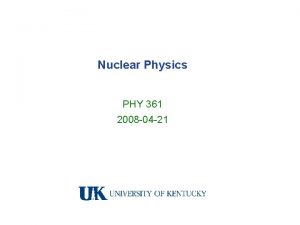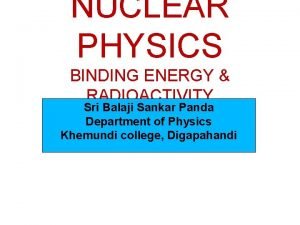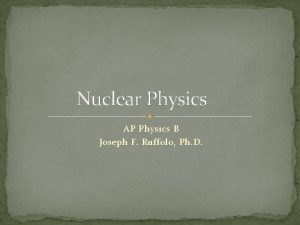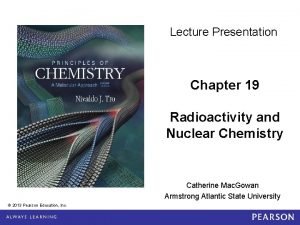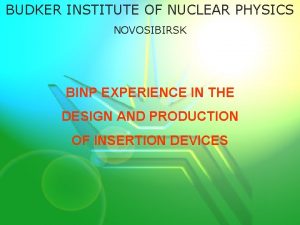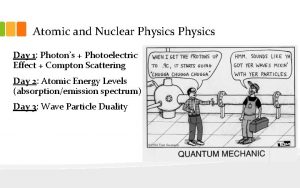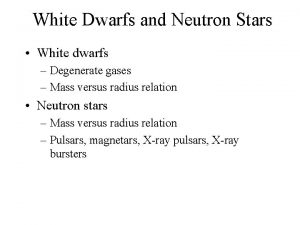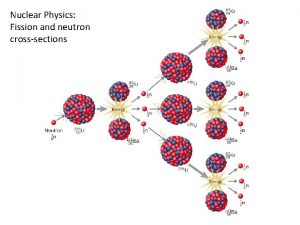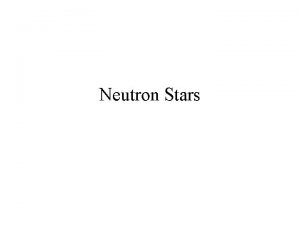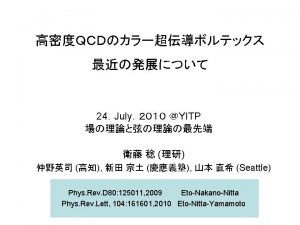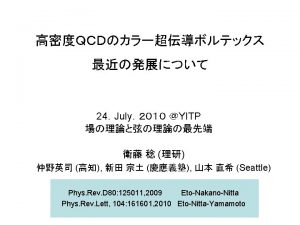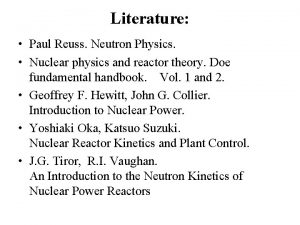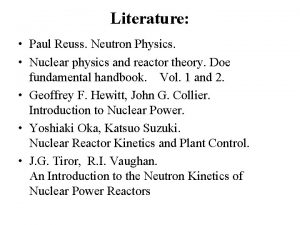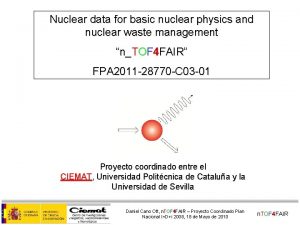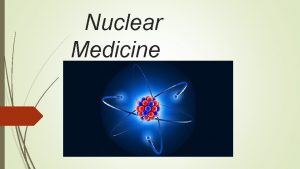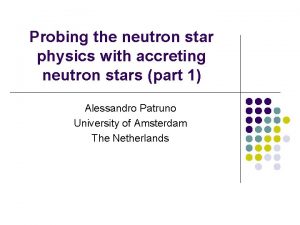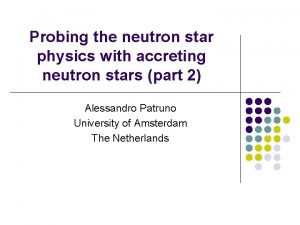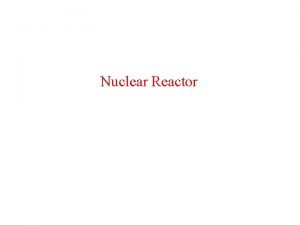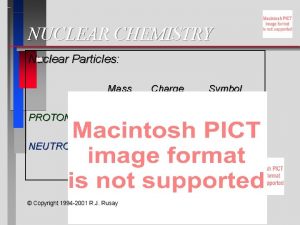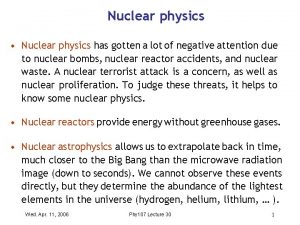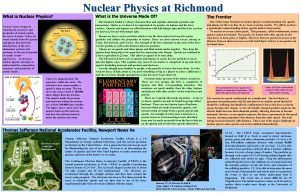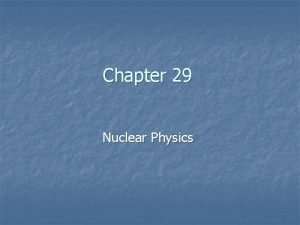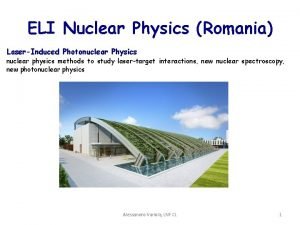XX International School on Nuclear Physics Neutron Physics




















- Slides: 20

XX International School on Nuclear Physics, Neutron Physics and Applications Cross-section studies of important neutron and relativistic deuteron reactions Vladimír Wagner Nuclear physics institute of CAS, 250 68 Řež, Czech Republic, E_mail: wagner@ujf. cas. cz for collaboration “Energy and Transmutation of Radioactive Waste” (Russia, Belarus, Germany, Greece, Poland, Ukraine, Czech Republic …) Relativistic deuteron reaction cross-section measurements Neutron reaction cross-section measurements

Importance of nuclear data Aplications: fission and fusion, nuclear medicine, object and material analysis, radiation protection , nuclear safety and security Science: astrophysical reactions, reactions and structure of nuclei, basic physics

Role of nuclear data Important – how well we calculate neutron fields, reaction rates, radioactivity …? what is the penalty for inaccuracy of our data libraries? Nuclear modeling lacks accuracy for detailed prediction of cross-sections Data are needed for developing models, determining model parameters, benchmark model parameter databases and overall model performance

ERINDA Transnational Access Activities The ERINDA project is an Integrated Infrastructure Initiative (I 3) funded under the 7 th framework programme (FP 7) of the European Commission. The ERINDA Project Start date: 1/1/2011 Duration : 4 years Beam time: 2600 hours Typical experiments: 26 Support: 80 manweeks The ERINDA Consortium 13 partners- 13 facilities hours for external users Web-site: www. erinda. org Project Coordinator: A. Junghans

CHANDA (New transnational Access EU Project) CIEMAT, ANSALDO, CCFE, CEA, CERN, CNRS, CSIC, ENEA, GANIL, GSI, HZDR, IFIN-HH, INFN, IST-ID, JRC, JSI, JYU, KFKI, NNL, NPI, NPL, NRG, NTUA, PSI, PTB, SCK, TUW, UB, UFrank, UMainz, UMan, UPC, UPM, USC, UU, UOslo Challenges in nuclear data for the safety of European nuclear facilities Coordinator: Enrique Gonzalez Infrastructure coord. & development 5. 4 M€ EC contribution, ≈10 M€ total 36 partners, 2013 -2017 New neutron beams, new experimental equipment, new evaluation methods, Myrrha safety case, access to validation experiments, transnational access

Development of ADT systems Benchmark studies of different set-ups irradiated by relativistic proton and deuteron beams – development of different codes (MCNPX, FLUKA …) Studies of neutron production and transport Studies of radioactive materials transmutation Group “Energy+Transmutation of Radioactive Waste”: Different set-ups irradiated by Nuclotron beams (JINR Dubna) Activation detectors are used for relativistic beam monitoring and neutron spatial distribution sudies Lead target + uranium blanket big uranium target simple led target +

Beam monitoring – aluminum and copper foils Very scare information about high energy deuteron aluminum reaction cross-sections Completely no information about high energy deuteron copper reaction cross-sections We started series of deuteron copper reaction studies by means of JINR Nuclotron Deuteron aluminum foils were used as beam integral monitor

Studies of relativistic deuteron reactions on natural copper (production of 57 Ni, 58 Co, 56 Co, 55 Co, 56 Mn, 52 Mn, 48 Cr, 48 V, 48 Sc, 47 Sc, 44 m. Sc, 43 Sc and 43 K) Energy range of deuteron beam from 1 Ge. V up to 8 Ge. V (during QUINTA irradiations) Five series of irradiations (last two - red signs) Activation method was used More measurements of activity More irradioations with same deuteron energy Example of simple decay results

48 Sc T 1/2 → 48 Ti ← 48 V 43. 7 h 383. 3 h Gamma lines: 48 Sc only: 1037. 6 ke. V (subtract 56 Co) + 48 V: 983. 5 ke. V and 1312. 1 ke. V

56 Mn T 1/2 → 56 Fe ← 56 Co 2. 6 h 1854. 5 h Gamma lines: 56 Co only: 1238. 3 ke. V + 56 Mn: 846. 8 ke. V

Isomeric state 44 m. Sc → 44 Ti T 1/2 58. 6 h T 1/2 (44 m. Sc) 3. 9 h >> T 1/2 (44 Sc) 44 m. Sc 44 Sc only N 01 information t→∞ 44 Sc from

Measurement of neutron reaction cross-sections Quasi-monoenergetic neutron source: protons from cyclotron + lithium target NPI ASCR Řež: Energy range 18 -37 Me. V, neutron intensity ~ 108 neutron cm-2 s-1 Beam-line TSL Uppsala: Energy range 25 – 180 Me. V neutron intensity ~ 105 neutron cm-2 s-1 Advantage of two neutron sources: very wide energy range, partial overlap – better estimation of systematical uncertainties p. Nuclear Graphite stopper Samples Li-target Instruments and Methods in Physics Research - Vol. 726, (2013) 84 -90

Yttrium cross-section measurement (ERINDA project) Only reactions (n, 2 n) and (n, 3 n) for energy up to 38 Me. V, systematic study of yttrium reactions using the NPI neutron source were done during last two years Yttrium – good material for activation detector Used by “Energy+Transmutation” collaboration Very scare data about cross-sections 87 m. Y T 1/2 = 13. 38 hours 380. 79 ke. V ε+β+ 9/2+ 1. 57(10) % << 98. 43(10) % No data about cross-sections of isomeric state production Long irradiation, intensive beam, only limited number of samples → possibility to measure yttrium sample many times to study systematic uncertainties of gamma measurements Important - isomeric state 87 m. Y study ε+β+ 87 Y 1/2 - T 1/2 = 79. 8 hours Reaction (n, 3 n) - production of isomeric and ground state of 87 Y

Accuracy of gamma spectroscopy measurement 88 Y 898 ke. V Source detector distance – 50 mm Yttrium – thicker sample (~ mm) → if different side facing to the detector → small difference: N(FFD) = 1. 539(3) 1013 N(FTD) = 1. 553(3) 1013 N(all) = 1. 546(2) 1010 Phenomena is quickly decreasing with bigger source detector distances


87 m. Y 87 Y t→∞

Scale 2 times lower

Total cross section of 87 Y production 1975, P. B. Bayhurts+ 1977, L. R. Veeser+

Cross section of 86 Y production

Conclusions • Experimental nuclear data for different applications (fast breeder reactors, Accelerator Driven Transmutation systems, fussion systems, spallation sources …. • European transnational access projects (European neutron sources for European users). Present ERINDA and new CHANDA. Neutron sources of NPI of ASCR Řež are open for users. • Benchmark studies by means different set-ups irradiated by relativistic proton and neutron beams. “Energy+Transmutation of RAW” collaboration uses Nuclotron beams (JINR Dubna). • The reactions of relativistic deuterons important for beam monitoring were studied using Nuclotron deuteron beam. • The quasimonoenergetic neutron sources are good tool for neutron crosssections measurements, perfect knowledge of these cross-sections is important for measurements of neutron field by means of activation detectors. Neutron reactions on yttrium samples were studied. • The understanding of all sources of systematic uncertainties is necessary • Such cross-section data are very important step to more effective usage of activation neutron detectors - we will continue such measurements
 Lesson 15 nuclear quest nuclear reactions
Lesson 15 nuclear quest nuclear reactions Fisión nuclear vs fision nuclear
Fisión nuclear vs fision nuclear Quantum and nuclear physics
Quantum and nuclear physics Magic nuclei
Magic nuclei Skobeltsyn institute of nuclear physics
Skobeltsyn institute of nuclear physics Nuclear energy
Nuclear energy Scattering cross section in nuclear physics
Scattering cross section in nuclear physics Budker
Budker Petersburg nuclear physics institute
Petersburg nuclear physics institute Physics topic 12
Physics topic 12 Nuclear physics
Nuclear physics Nuclear physics topics for presentation
Nuclear physics topics for presentation Nuclear physics
Nuclear physics Nuclear physics
Nuclear physics Nuclear physics
Nuclear physics Nuclear physics b
Nuclear physics b Magic number
Magic number Nuclear physics
Nuclear physics Budker
Budker Nuclear physics day
Nuclear physics day Angular momentum
Angular momentum



